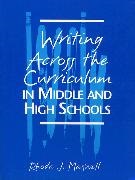Read more
List of contents
1. Writing across the Curriculum.
Writing in Every Subject.
Purposes of Writing.
Writing as Thinking.
Types of Writing.
Traits of Middle and High School Students.
Learning Styles.
Classroom Environment.
Planning for Writing across the Curriculum.
2. Writing as a Process.
Stages of the Writing Process.
Discovery: Brainstorming, Mapping, Outlining, Creative Dramatics Drafting Revising: Response Groups Editing Publishing
Teacher Help.
3. Levels of Writing.
Determining Levels.
Functions of Writing.
Levels of Speech.
Descriptions of Levels of Writing.
Level One Level Two Level Three
Frequency of Levels.
Expectations and Evaluations.
Length of Writing by Levels.
Writing Levels within Assignments.
Science English English as a Second Language
4. Journals.
Purposes of Journals.
Types of Journals.
Personal Learning Logs Project Response Writer's Notebook Class Logs
5. Writing as a Means of Learning.
Strategies for Learning.
Note Taking.
Graphic Organizers.
Developing Questions.
Summarizing and Paraphrasing.
Writing Reports and Research Papers.
6. Improving Writing Skills.
Levels of Writing.
Common Errors.
When to Teach Writing Skills.
Vocabulary and Spelling.
Handbooks.
7. Writing in Math and the Sciences.
Types of Writing.
Math.
Communication in Math Writing Explanations Narrative Writing Group Work Math Vocabulary
Science.
Writing Activities Poetry in Science Writing Detailed Descriptions Writing Books for Younger Children What Do Scientists Do? Informational Writing Learning Log Activities
Writing in Health Class.
8. Writing in the Social Studies.
Types of Writing.
Writing Activities.
Linking Social Studies and Journalism.
Examining Preconceived Ideas.
Writing Reports.
Writing Scripts.
Examining Propaganda.
Writing Based on Biographies.
Writing Fiction.
Experiencing the Legal System.
9. Writing in Art and Music.
Writing in Art Classes.
Vocabulary for Art Art and Literature Types of Writing in Art
Writing in Music Classes.
Standards in Music Classes Music and Social Change Music and Writing Children's Books
10. Evaluation of Writing.
Purposes of Evaluation.
Types of Evaluation.
Informal Self Evaluation Impression Analytical Scales
Student Involvement in Evaluation.
Portfolios
Assessment.
Holistic Scoring
11. Interdisciplinary Units.
Rationale for Interdisciplinary Teaching.
Planning Interdisciplinary Curricula.
Thematic Units.
Tracing One's Roots Analyzing Household Products Columbus's Voyages Preserving the Rain Forests Prehistoric Cultures Science and Society Power of Media Representations of History through the Arts
Summary
Writing Across the Curriculum in Middle and High Schools lays the foundation of writing instruction with an explanation of the writing process, including classroom examples implemented throughout the curriculum. The levels of writing provide a common-sense way to approach evaluation and at the same time offer practice for writing. Writing is so much more than the usual term paper, and this book explains a multitude of ways to incorporate writing into the curriculum. A variety of instructional methods are described, including portfolios. The book includes examples of students' writing and teachers' planning, and interdisciplinary units illustrate how to combine areas to more closely mirror real-life situations. This text presents writing as a tool for learning information, understanding concepts, and retaining knowledge. It is through writing that instructors can encourage students to become active learners, and this text helps instructors facilitate that goal.

